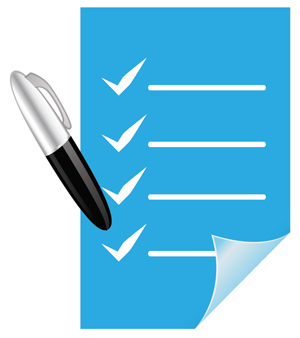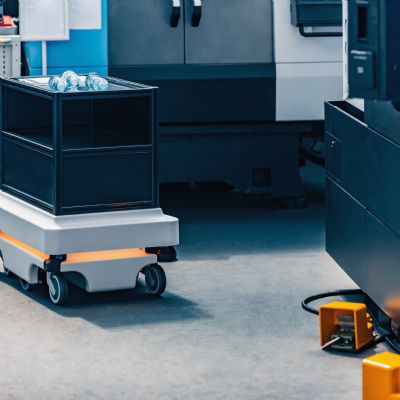Fire-Emergency Procedures
• Is there a clear fire-response plan posted for each work area, and do all workers know the plan?
 • Are drills held regularly?
• Are drills held regularly?
• Are fire extinguishers chosen for the type of fire most likely in that area?
• Are there enough extinguishers present to do the job, are they properly mounted and easily accessible, and their locations conspicuously marked?
• Are all extinguishers fully charged and operable?
• Are special purpose extinguishers clearly marked?
Means of Exit
• Are there enough exits to allow prompt escape?
• Do employees have easy access to exits?
• Are exits unlocked to allow egress?
• Are exits clearly marked, and exit routes equipped with emergency lighting?
Warehouse and Shipping
• Are dock platforms, bumpers, stairs and steps in good condition?
• Are light fixtures in good condition?
• Are all work areas clean and free of debris?
• Are stored materials properly stacked and spaced?
• Are tools kept in their proper place?
• Are there metal containers for oily rags and for rubbish?
• Are floors free of oil spillage or leakage?
• Is absorbent available for immediate cleanup of spills and leaks?
• Are all flammable and combustible products stored appropriately? For example, are Class I flammable products (as per NFPA or your local fire code) stored in Class I approved buildings or outside the warehouse?
Loading/Unloading Racks
• Are steps, railings and retractable ramps on raised platforms in good repair?
• Is piping and inline equipment in good condition and free of leaks?
• Are loading arms operating satisfactorily?
• Do submerged filling two-stage valves operate properly?
• Are bonding and grounding cables free of breaks or damage?
• Are connections tight and sound?
• Is the general condition of wiring and junction boxes in good condition?
Lighting
• Is the level of light adequate for safe and comfortable performance of work?
• Does lighting produce glare on work surfaces, monitors, screens and keyboards?
• Is emergency lighting adequate and regularly tested?
Machine Guards
• Are all dangerous machine parts adequately guarded?
• Do machine guards meet standards?
• Are lockout procedures followed when performing maintenance with guards removed?
Electrical
• Are all machines properly grounded?
• Are portable hand tools grounded or double insulated?
• Are junction boxes closed?
• Are extension cords out of the aisles where they can be abused by heavy traffic?
• Is permanent wiring used instead of extension cords?
Tools and Machinery
• Are manufacturers’ manuals kept for all tools and machinery?
• Do power tools conform to standards?
• Are tools properly designed for use by employees?
• Are defective tools tagged and removed from service as part of a regular maintenance program?
• Are tools and machinery used so as to avoid electrical hazards?
• Is proper training given in the safe use of tools and machinery?
Confined Spaces
• Are the confined-space procedures and training available and followed by all involved?
• Are entry and exit procedures adequate?
• Are emergency and rescue procedures in place (e.g. trained safety watchers)?
Housekeeping
• Are work areas clean and orderly?
• Are floors free from protruding nails, splinters, holes and loose boards?
• Are aisles and passages kept clear of obstructions?
• Are permanent aisles and passages clearly marked?
• Are covers or guardrails in place around open pits, tanks and ditches?
Floor and Wall Openings
• Are ladder-s and door openings guarded by a railing?
• Do temporary floor openings have standard railings or someone constantly on guard?
Stairs, Ladders and Platforms
• Are stairs and handrails in good condition?
• Are ladders free of defects?
• Are ladders set up properly before use?
• Are elevated platforms properly secured and do they have handrails?
Elevating Devices
• Are elevating devices used only within capacity?
• Are capacities posted on equipment?
• Are they regularly inspected, tested and maintained?
• Are controls of the “dead-man” type?
• Are operators trained?
Sound Level/Noise
• Are regular noise surveys conducted?
• Is hearing protection available and properly used?
Temporary Work Structures
• Are temporary work structures used only when it is not reasonably practicable to use permanent ones?
• Are excavations properly shored, free of large objects (rocks, etc.) at the edges?
Employee Facilities
• Are facilities kept clean and sanitary?
• Are facilities in good repair?
• Are cafeteria facilities provided a from toxic chemicals?
• Are hand-washing facilities available?
Medical and First Aid
• Do all employees know how to get first-aid assistance when needed?
• Do the first-aiders know when and to which hospital or clinic an injured person should be taken?
• Are there employees trained as first-aid practitioners on each shift worked?
• Are first-aid kits provided, and first-aid supplies replenished as they are used?
Personal Protective Equipment (PPE)
• Is required PPE provided, maintained and used?
• Does equipment meet requirements and is it reliable?
• Is personal protection used only when it is not reasonably practicable to eliminate or control the hazardous substance or process?
• Are the areas requiring PPE usage properly identified by warning signs?
Material Handling and Storage
• Is there safe clearance for all equipment through aisles and doors?
• Is stored material stable and secure?
• Are storage areas free from tipping hazards?
• Are only trained operators allowed to operate forklifts?
• Is charging of electric batteries performed only in designated areas?
• Are dock boards (bridge plates) used when loading or unloading from dock to truck or dock to rail car?
• Are necessary warning devices and signs in use for rail sidings?
• Are specifications posted for maximum loads, which are approved for shelving, floors and roofs?
• Are racks and platforms loaded only within the limits of their capacity?
• Are chain hoists, ropes and slings adequate for the loads and marked accordingly?
• Are slings inspected daily before use?
• Are all new, repaired or reconditioned alloy-steel chain slings proof-tested before use?
• Are pallets and skids the correct type and inspected?
• Do personnel use proper lifting techniques?
• Is the size and condition of containers hazardous to workers?
• Are elevators, hoists, conveyors, balers, etc., properly used with appropriate signals and directional warning signs? Technologies: Safety






 • Are drills held regularly?
• Are drills held regularly? 
